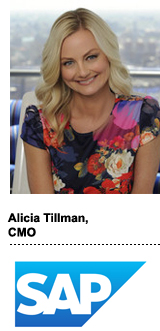
What do an international pop group, the creator of “American Idol,” Cirque du Soleil and actor Clive Owen have in common?
SAP.
“Marketers in the B2B space have to realize one very simple and fundamental thing: We are all human beings,” said Alicia Tillman, SAP’s chief marketing officer. “We as B2B marketers need to speak to a much broader audience.”
Typically, B2B marketing focuses on reaching a handful of decision-makers within a given organization, including – hopefully – that one person who ends up signing the contract.
But numerous people involved in the buying process for enterprise software spend just a fraction of their lives in the office, Tillman said.
That’s why SAP is spending more on event sponsorships and partnering with Cirque du Soleil, which used SAP technology to create an app with interactive content for one of its shows, “Toruk.” SAP is also developing a digital hub for fans of Now United, the latest pop group from Simon Fuller, the impresario behind the “Idol” franchise.
SAP hired British actor Clive Owen as a spokesman last year because he’s relatable and can “humanize” the brand, said Tillman, who became CMO for SAP’s Ariba brand in 2015 and CMO for SAP in 2017 after 11 years at American Express.
“Brand really matters,” she said. “It matters in people’s perceptions and it leads people to decide whether or not they’re going to buy your product and become a customer for life.”
Tillman spoke with AdExchanger.
AdExchanger: Until recently, you split the chief marketing role with Mika Yamamoto, who left SAP in August to join Marketo. What do you have on your plate today?
ALICIA TILLMAN: I’ve taken on all of the digital capabilities, including our tech stack, our digital transformation priorities, our demand center, marketing automation, our social media, our audience efforts, programmatic campaigns, sponsorships, branded events, strategic partnerships and strategy overall.
That’s a lot. You’ve spoken about why taking a consumer approach to B2B marketing is important, but also that it’s very challenging. What makes it to tricky to pull off?
Regardless of the company or the industry, B2B decision-makers are looking to cut costs, make efficiency gains and generate top-line growth, and that is what B2B marketers message to. The challenge is that there are many, many more influencers involved in the decision process today.
Employees are no longer willing to use subpar technology to deliver on business goals. They want systems that run as efficiently as the ones they use in their consumer lives – and they’re speaking up about it.
Sure, there may still be one person who signs the contract for a new piece of technology, but they’re being influenced more than ever by the people who are tasked with actually using that technology. We have an obligation as marketers to get their attention, the day-to-day users. It comes down to recognizing that everyone is a consumer.
What are some examples of SAP appealing to consumers as humans, not just targets?
We have a very healthy sponsorship portfolio, because those partnerships can be a gateway to the consumer. We partner with organizations all over the world that appeal to people of all demographics in all markets, from the NBA to the Women’s Tennis Association to Cirque du Soleil.
All of these organizations are trying to understand their fans better so they can create experiences that resonate – not that different from how we create personalized content for our own consumers – and we deploy SAP technology to analyze data and help them do that. It’s a unique way for us to position the SAP brand.
How does SAP approach personalization?
Personalization is key – and far more difficult in the B2B space, where we’re so used to focusing only on decision-makers. As we expand our focus, we’re thinking about how personalization can be applied to our products, our websites and our physical events.
Similar to a consumer-facing retail or ecommerce site, we watch digital behavior so that we can serve up content based on what you’re interested in. We do the same for our events. When people arrive, they get a personalized agenda based on what we think they should see, touch and feel while they’re there. Tens of thousands of people attend our Sapphire event, for example, which can be overwhelming. We can help by curating their experience.
How do you think about measuring success?
The No. 1 KPI is marketing’s contribution to year-over-year revenue, which comes in two forms: demand and retention. We also look at net new names, which are the new accounts marketing is bringing into the pipeline, and at purchase consideration, reputation and consideration.
But typical brand measures are also very important to us. We look at the brand studies put out by Kantar and Interbrand. In the Kantar BrandZ study this year, we were the 17th most valuable brand in the word, up from the 21st last year. That’s the highest growth we’ve had since 2009.
Along with our CEO, Bill McDermott, I have the aspiration for us to enter the top 10. It’s tough if you look at the other brands sitting there – Google, Amazon, Apple – but we have every desire to keep growing and every desire to keep moving.
This post was syndicated from Ad Exchanger.


More Stories
Marketing Morsels: Hidden Valley Ranch, La-Z-Boy, Topps & More
Flashback: Jane Pauley and Deborah Norville Revisit Today’s 1989 Succession Drama
Ally Financial Revives ‘Banksgiving’ With A TikTok Twist